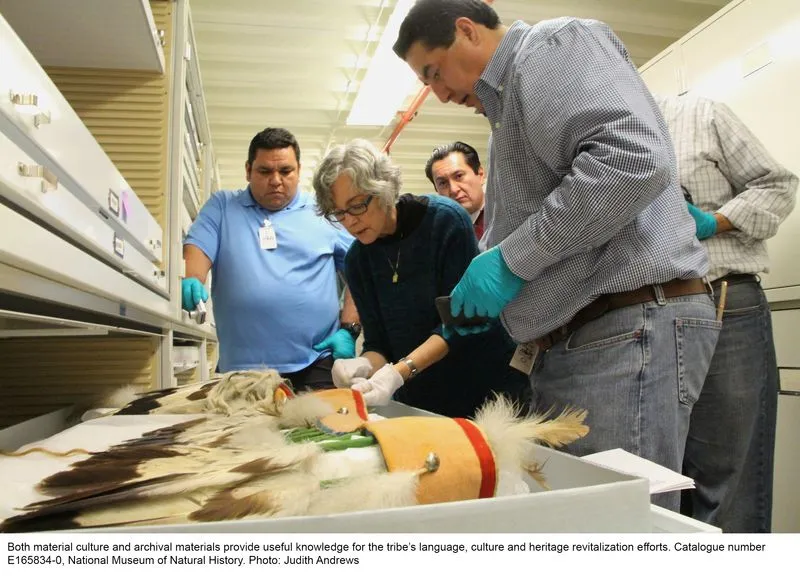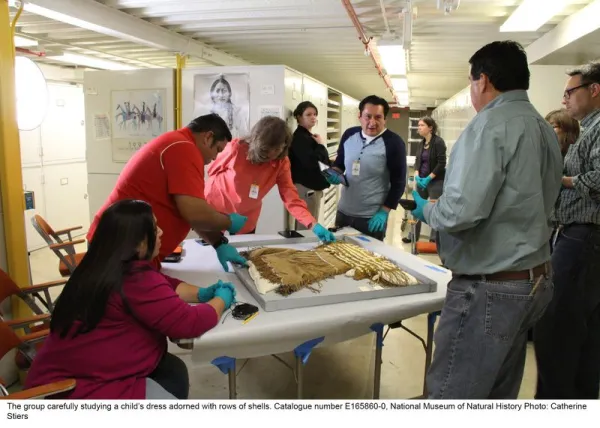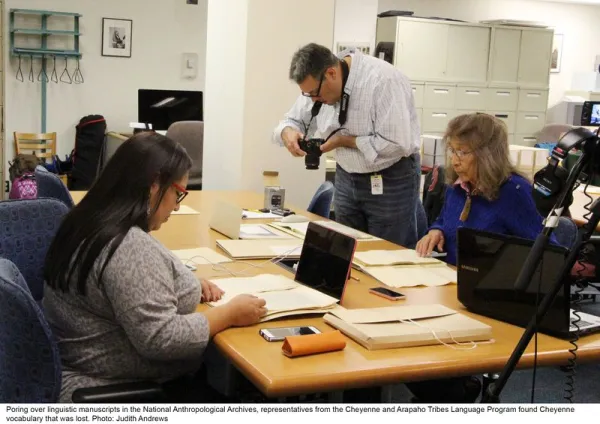
Search

News from Recovering Voices
A Holistic Revitalization Approach from the Cheyenne and Arapaho Tribes
By: Catherine Stiers
12/03/2015

Language and culture are not easily separated- material culture can be a repository of both, as evidenced by the most recent Recovering Voices Community Research visit. The delegation, made up of members from the Cheyenne and Arapaho Tribes in Oklahoma, spent the first week in November studying many facets of Cheyenne heritage in the Smithsonian’s collections and archives. The group included representatives from the tribe’s Language Program and the Culture & Heritage Program, as well as Cheyenne artists. They shared an interest in a holistic approach to revitalizing and sustaining their language, culture and heritage by recognizing the integrated nature of the Cheyenne language with games, art, crafts and ceremony.
Each member of the research team brought with them specialized knowledge to share with the group and the knowledge of what to look for in the collections. One week is not long enough to see everything, the group focused on Cheyenne games, beadwork, clothing, and warrior items at both the National Museum of Natural History and the National Museum of the American Indian. Knowledge from each of these object categories will be incorporated in a variety of youth and community programs. The tribe’s workshops and programming on traditional games and knowledge are not in isolation from language; the programming works together to nurture a community of Cheyenne speakers and future leaders in the younger generations, as well as being resources for adults in the community.

While researching clothing, which included dresses, moccasins and leggings, many notable items were found. Although every item studied was of interest, a few items brought unique stories to the minds of individuals in the group. One group member described her dresses growing up: each new ceremonial dress had a more intricate or elaborate design than the last. She would pass down her old dress to the next girl in the family, and likewise, her dresses came from someone older. Several of the dresses in the Anthropology collections featured rows of elk teeth and the ivories on one unique dress were incised, something that no one in the group had seen before.
Some of the beadwork designs on clothing and bags instigated discussions of the differences between designs used by different tribes. The history of the Cheyenne does not rule out trade or intermarriage between tribes. It is likely that a marriage may have carried beaded items and the knowledge of designs between tribes. This complicates the matter of tribal attribution in a museum catalogue as well as using a museum’s collection to determine what designs historically belonged to which tribe. Through conversations and collaborations with research groups like the Cheyenne, complications or inconsistencies in the museum’s catalogue information can be updated or corrected.

The research group also spent a day in the NMNH’s National Anthropological Archives. At the archives the group was able to access linguistic manuscripts, ledger art and historical photographs that have not yet been digitized. The group took home digital surrogates of manuscripts already digitized. By studying manuscripts collected from the late 19th and early 20th centuries, they found words that had gone missing from the tribe’s collective memory. These new words will fill in some gaps within their Cheyenne language curriculum.
The Cheyenne language is no longer being taught in the home, unless the household is fortunate to have someone who knows the language in the home. They believe that in teaching the language, focusing on correct grammar and spelling is not the most important aspect of creating a new generation of Cheyenne speakers, but that Cheyenne should be used on a daily basis- around the table at mealtime, at school, or during a tribal program. A fear is that modern technology is drawing Cheyenne youth away from learning traditional skills and language. By creating engaging programs designed to attract the attention of children and youth, the tribe plans to counter the loss of Cheyenne language and cultural knowledge.

The varied categories of objects and archives accessed during the Cheyenne’s Community Research Visit highlights the diversity of heritage knowledge that is held in the Smithsonian’s repositories and supports the integrated approach the Cheyenne and Arapaho Tribes are taking to revitalize their cultures and languages. Knowledge taken home from this research trip will be used to inform programs that embody a holistic revitalization of language, culture and heritage.